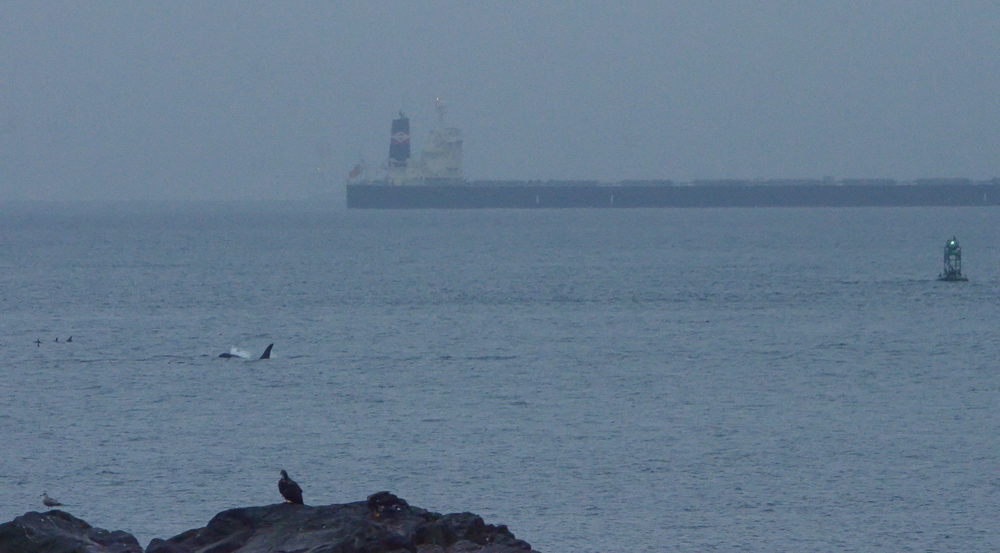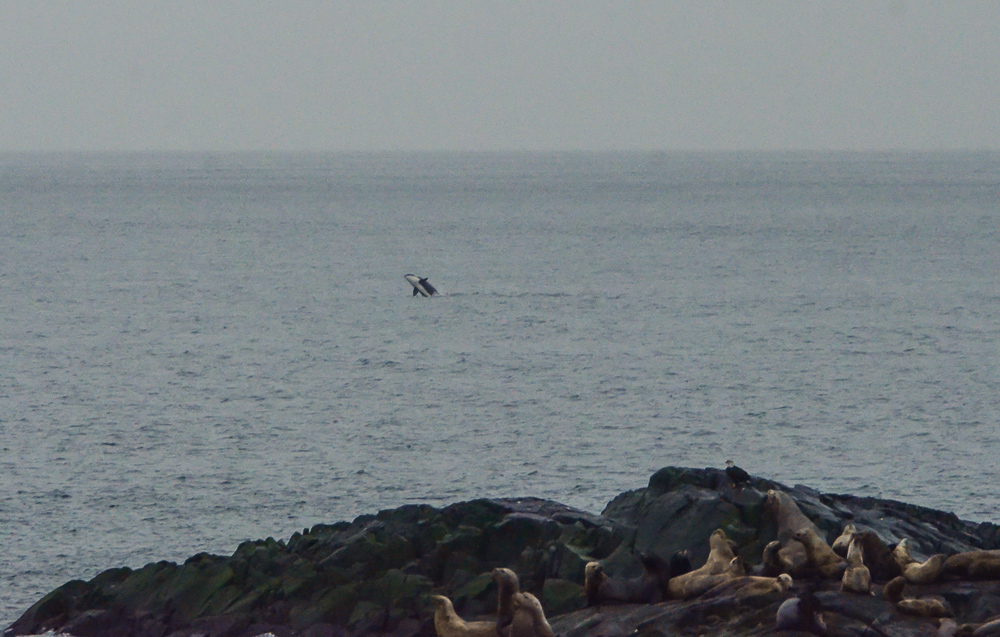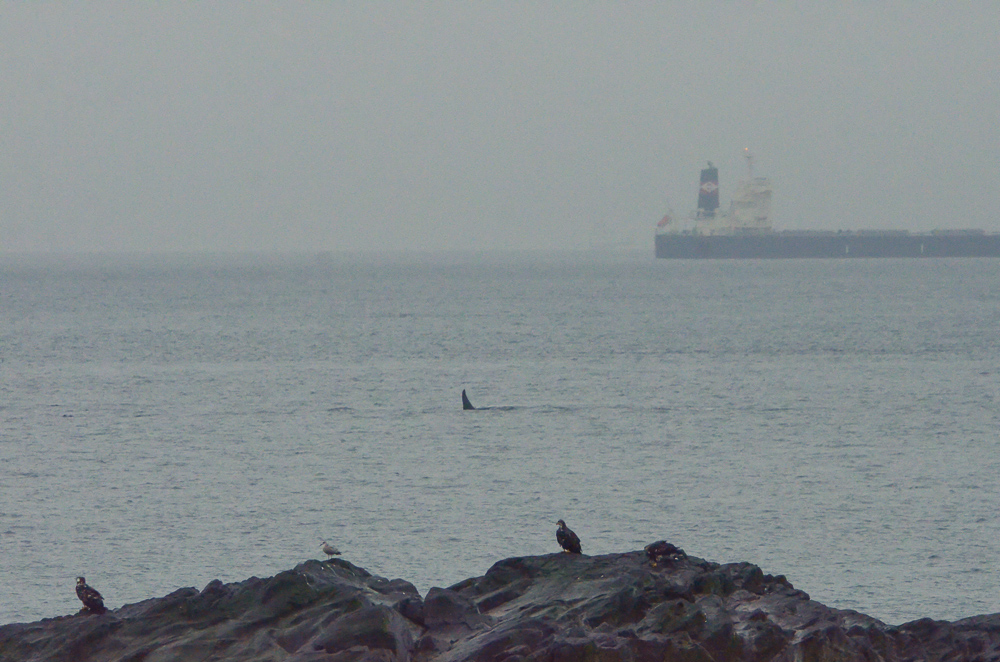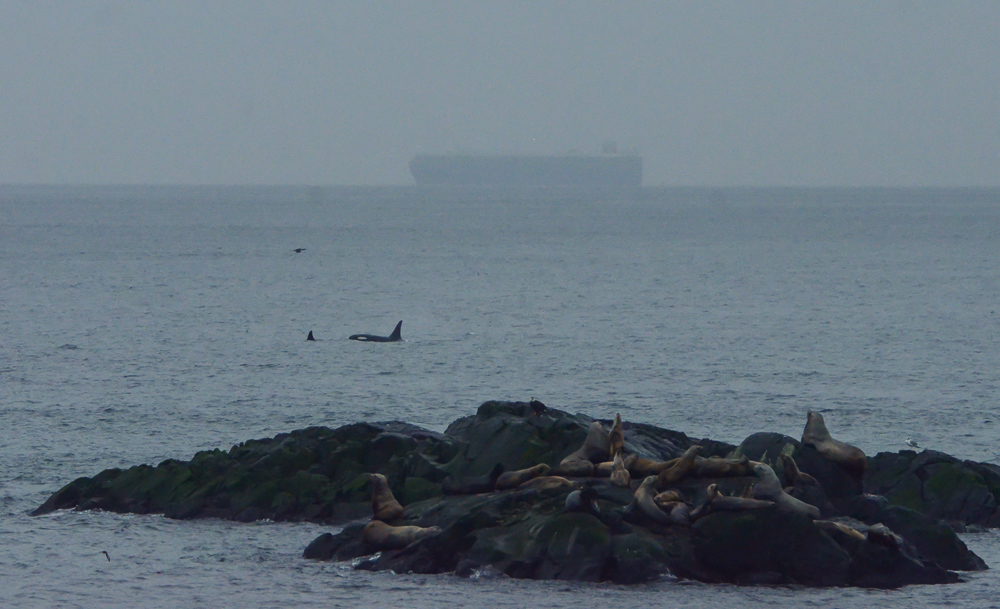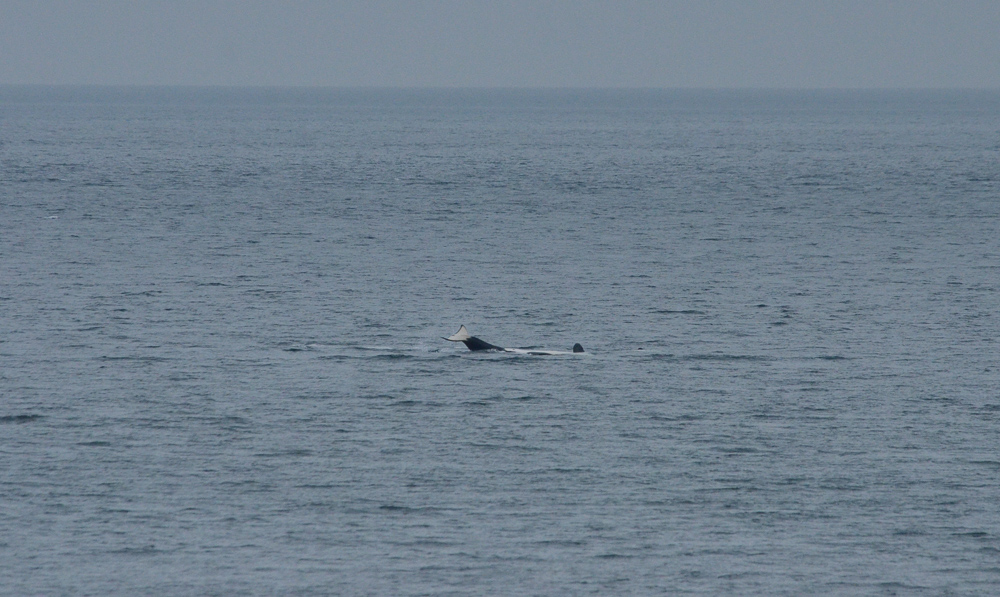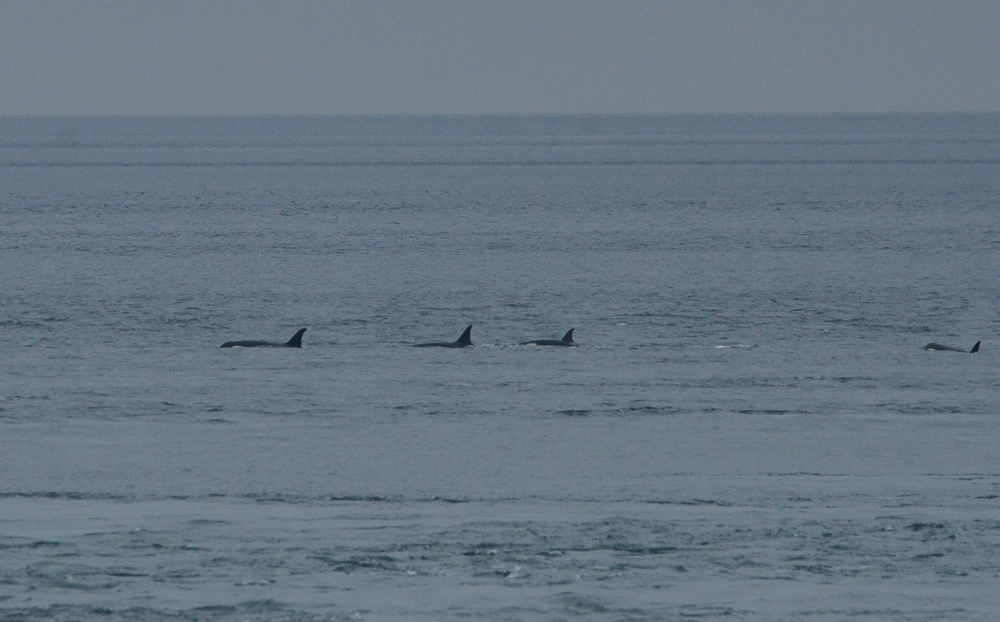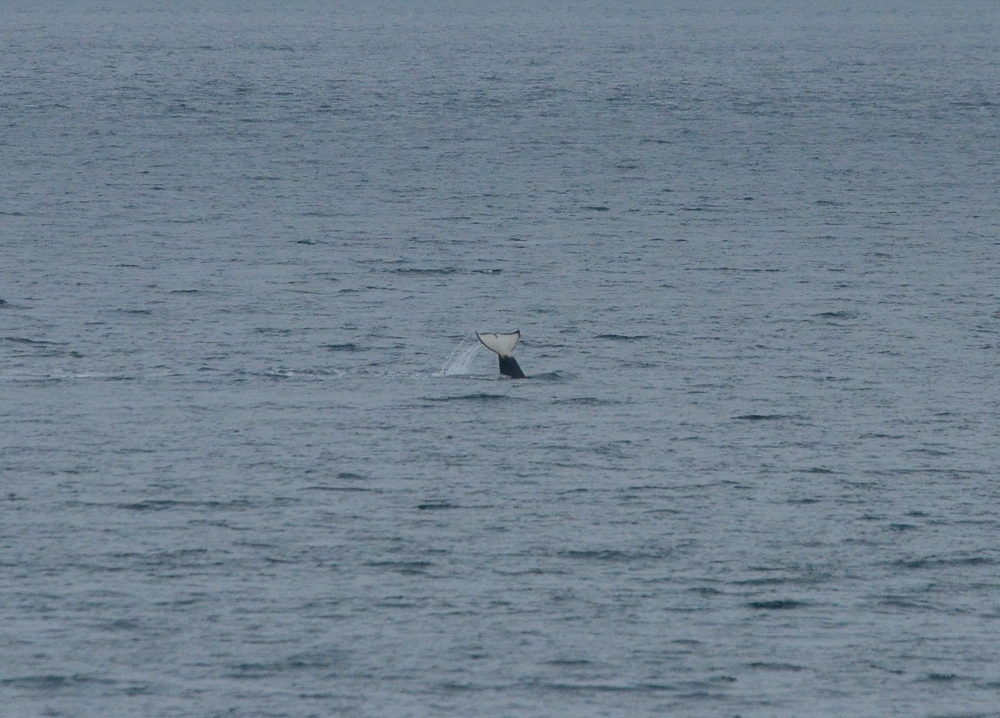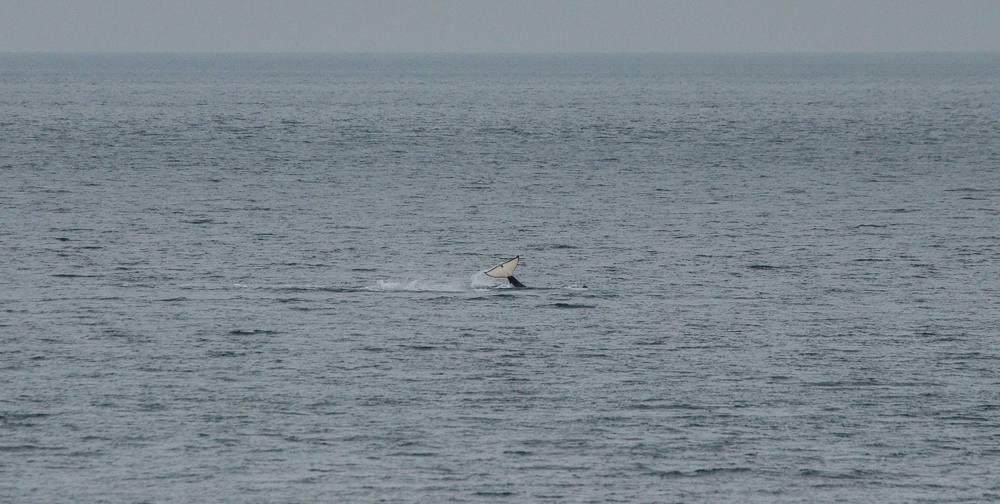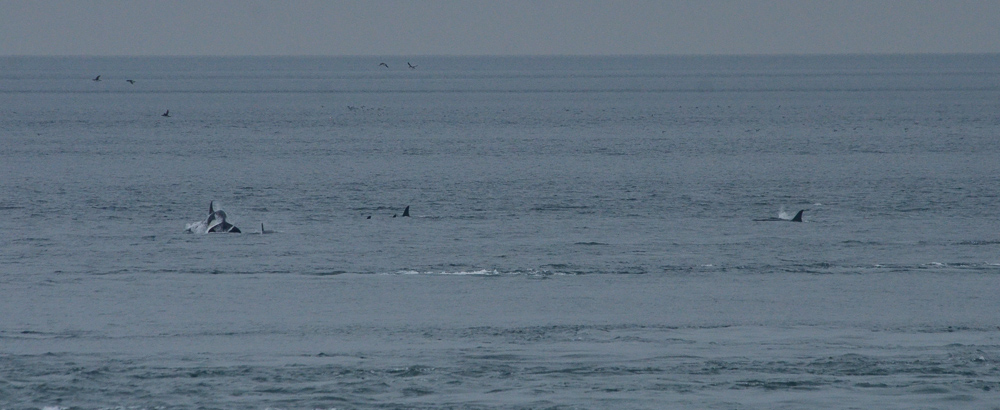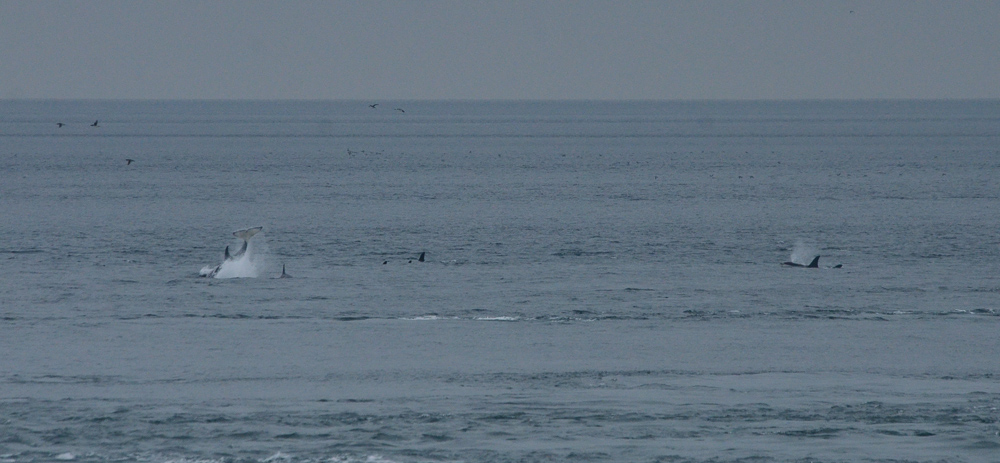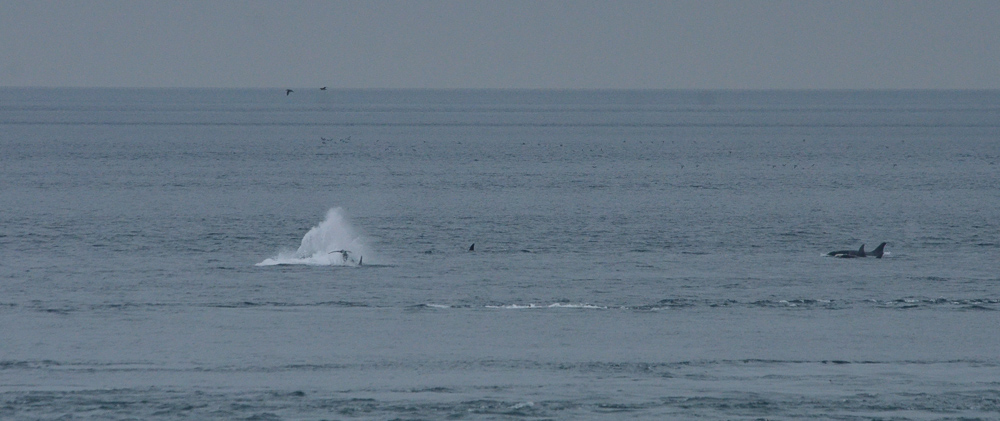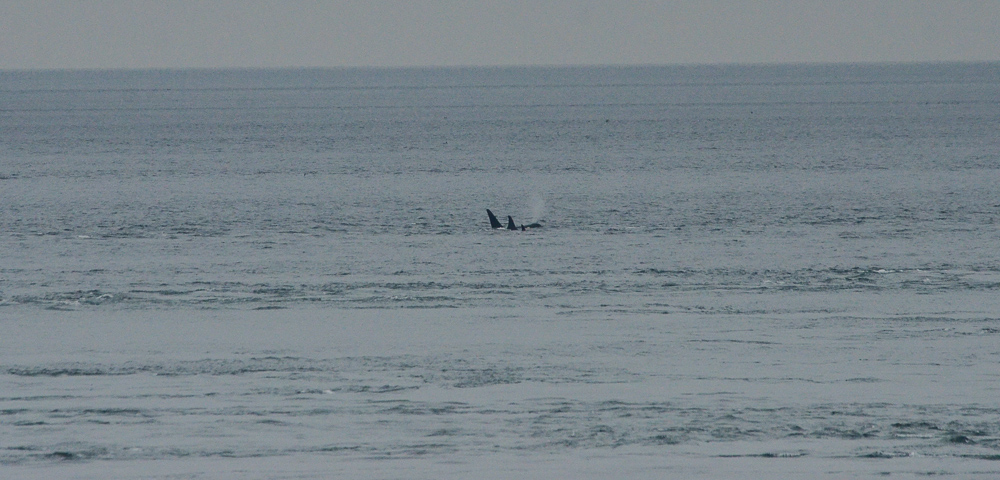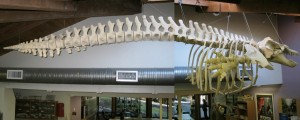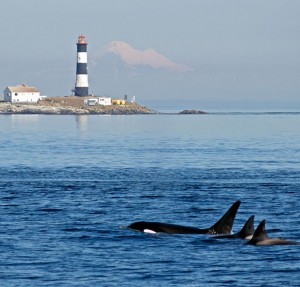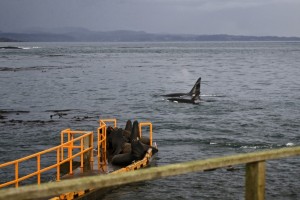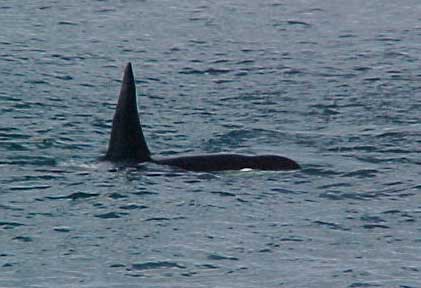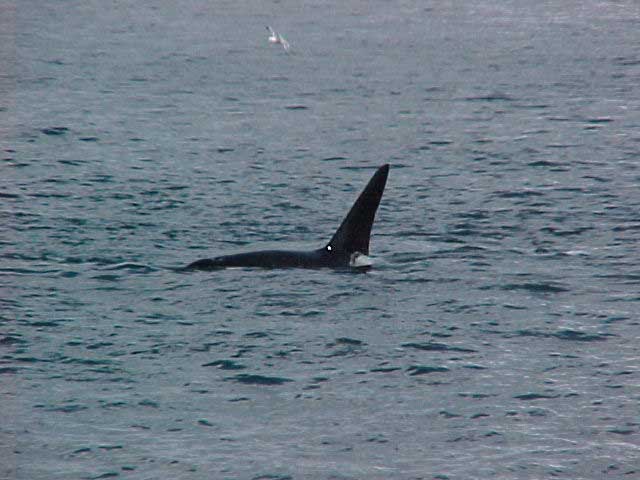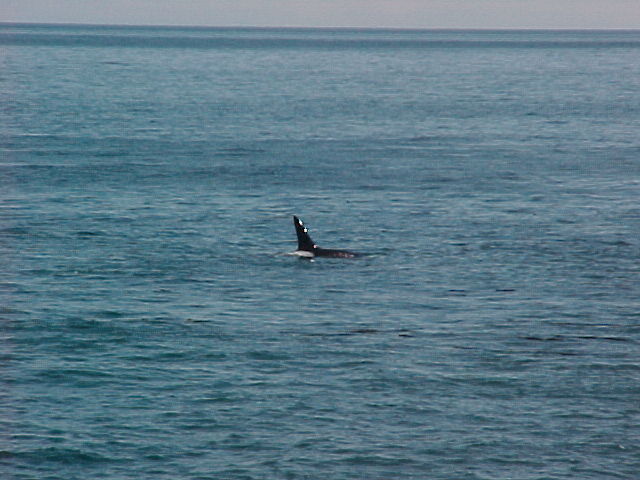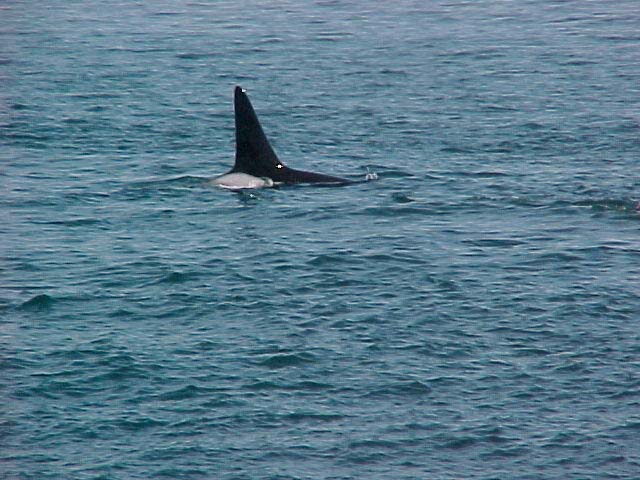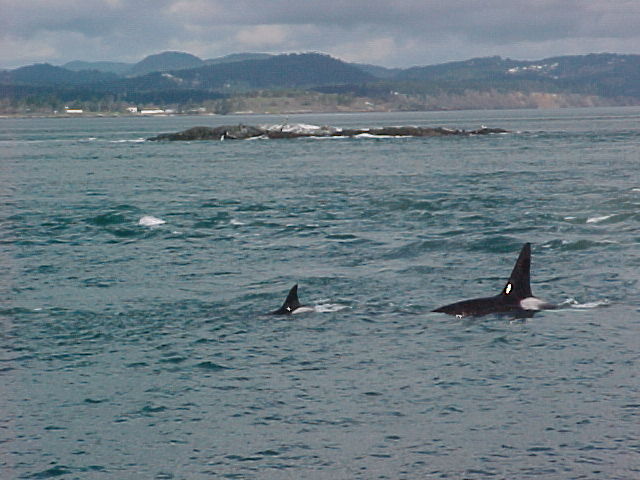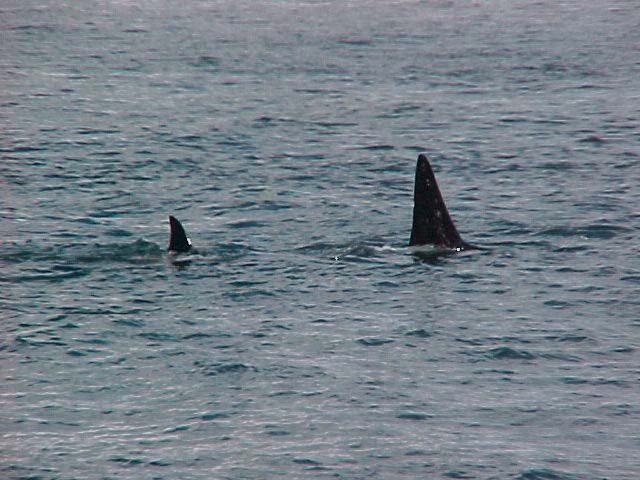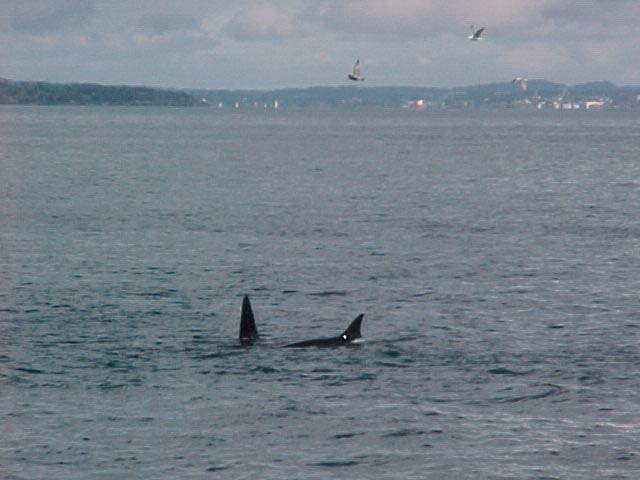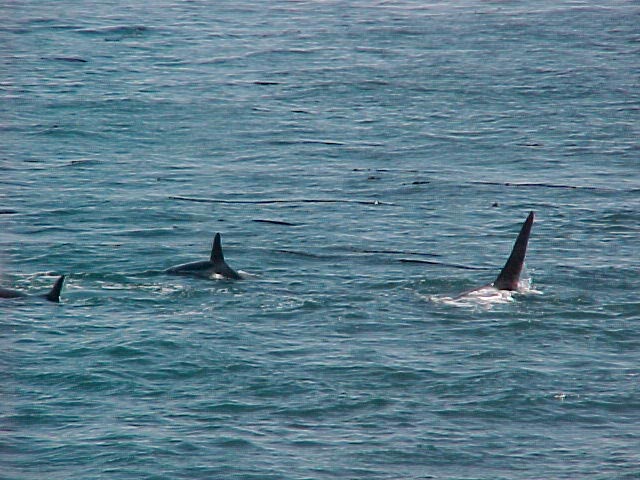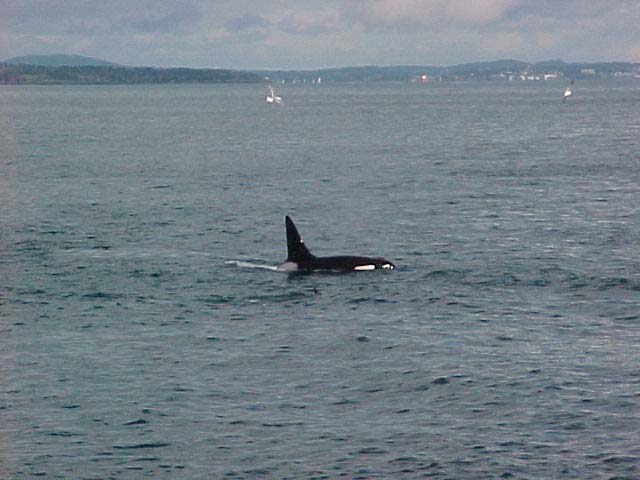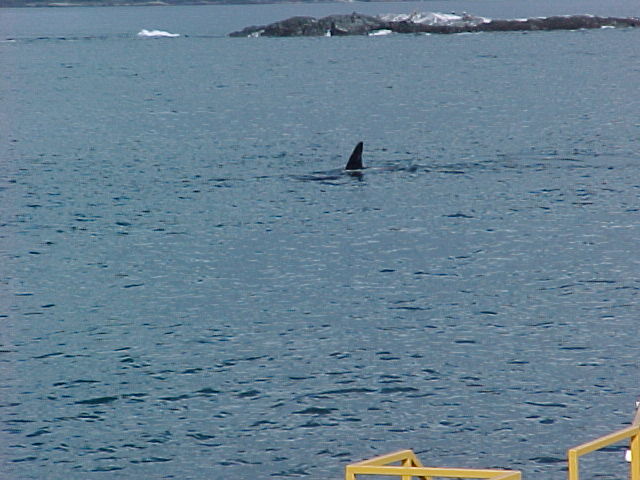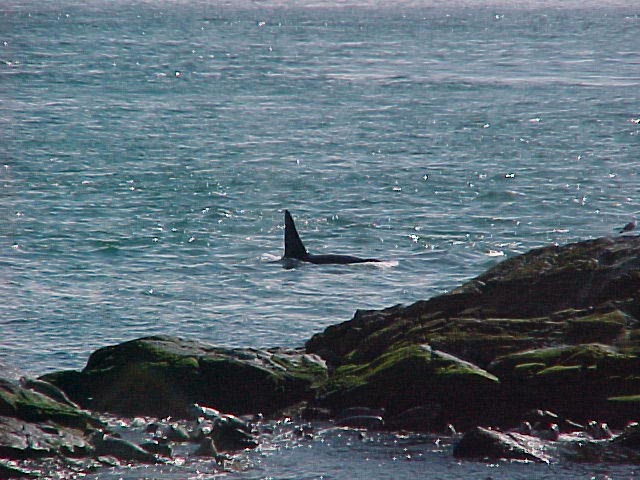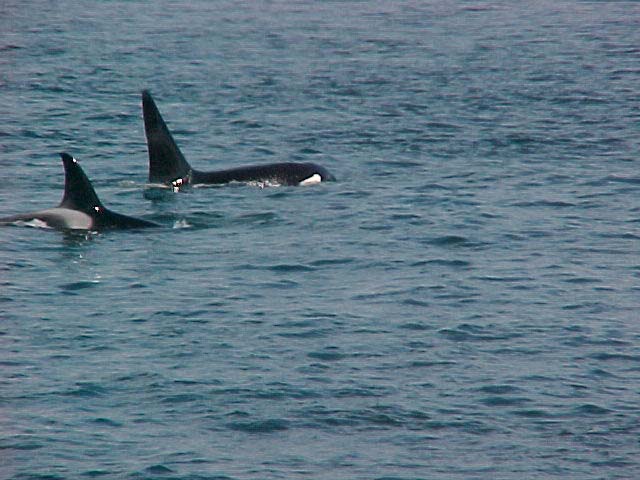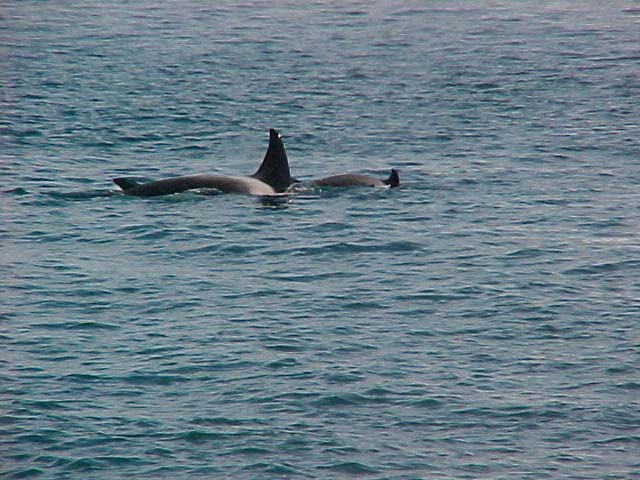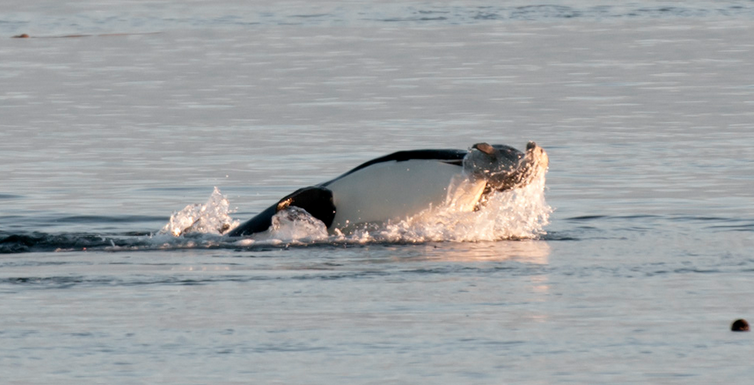
Orcinus orca with prey– photo by Ryan Murphy, Sept 21 2010
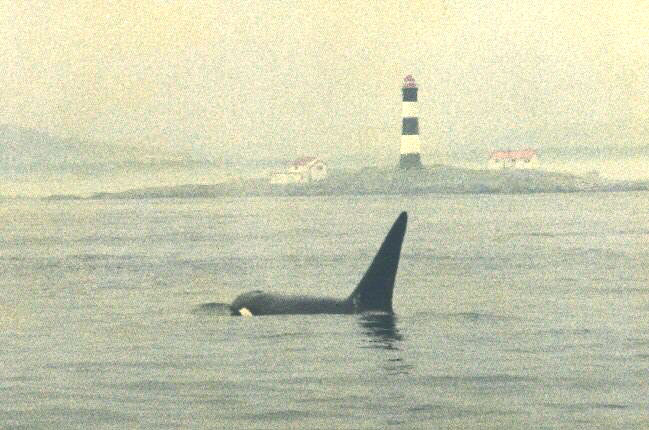
In 1978, a group of divers from Lester Pearson College were mapping the underwater life in the Rosedale Reef area just South of Great Race Rocks. A large bull orca, from a transient pod surfaced near the boat. Duane Prentice who was then a student in the Diving Service at Pearson College, took this photo from the dive boat. The photo was featured the following year in the Lester Pearson College Proposal for an Ecological Reserve at Race Rocks. Duane is now a photo-journalist living in Victoria.
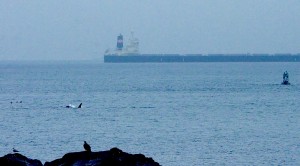
This image of a bulk carrier , whales and eagles is one that was added to our Oil Spill and Animals at Race Rocks page photos by Alex Fletcher.
In the Ecoguardian log of January 13, 2014, Alex Fletcher reported his sightings of Orcas that week at Race Rocks Ecological Reserve. See the images below:
Physical characteristics:
Size:
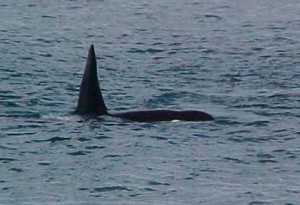
From one of the Race Rocks Activity pages of 2002: “We spotted an Orca on our way back to Pearson College from Race Rocks. An exciting end to an exciting day.”
Although small compared to some whales, killer whales are the largest predators of mammals known. Male killer whales, or bulls, average 5.8 to 6.7 m (19-22 ft.) and usually weigh between 3,628 and 5,442 kg (8,000-12,000 lb.). Females, or cows, average 4.9 to 5.8 m (16-19 ft.) and usually weigh between 1,361 and 3,628 kg (3,000-8,000 lb.). Individual sizes vary significantly between geographical areas. Length estimates for more than 2,000 killer whales taken by North Atlantic whaling operations show male North Atlantic killer whales average about 6.1 m (20 ft.) while females average about 5.5 m (18 ft.).
Body Shape:
A killer whale has a sleek, streamlined, fusiform (tapered at both ends) body shape.
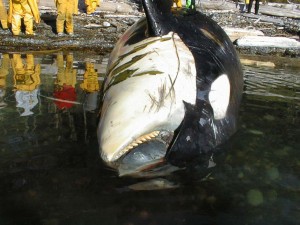 On Sept 25, 1999 students from Pearson College and teacher Catrin Brown went out to Whirl Bay to retrieve the bones of a female Orca, L21 who had died.
On Sept 25, 1999 students from Pearson College and teacher Catrin Brown went out to Whirl Bay to retrieve the bones of a female Orca, L21 who had died.
The photos and story of that episode can be found in this post.
See images of the skeletal mount which now hangs in the biology lab at Pearson College
Coloration:
The dorsal surface and pectoral flippers are black, except for the gray saddle area located just behind the dorsal fin. The ventral (bottom) surface, lower jaw, and undersides of the tail flukes are mostly white. The undersides of the tail flukes are fringed with black. A white ‘eyespot’ is located just above and slightly behind each eye. The markings on the flukes and saddle patch have been used as the standard method of identification of Killer whales. Their vocalizations were researched in the 1980’s by John Ford. He spent many hours in the Race Rocks and the rest of the waters around Vancouver Island for his research.
Ryan Murphy has taken pictures of the Orcas that he has seen in the Ecological reserve since 2009.See this Flickr set for the complete set.
Photos below by
Roberto Serpelloni, (PC yr 25) March, 2000
Kingdom Animalia
Phylum Chordata
Sub-Phylum Vertebrata
Class Mammalia
Sub-Class Eutheria
Order Cetacea
Sub-Order Odontoceti
Family Delphinidae
Genus Orcinus
Species orca
Behavior:
Sound travels well in water and orcas communicate with calls, clicks and whistles. They use ‘echolocation’ clicks to navigate and find food. Orcas can leap out of the water to ‘breach’. Orcas also ‘spy-hop’, rising vertically in the water with their heads in the air, looking around.
Permanent mother-led family groups form extended families called ‘pods’. Though mothers are the primary caregivers, everyone plays a part in caring for the young. The social life is vital. Each pod has its own distinct dialect.
A collage of pictures of an Orca killing a seal- taken from the video..
Living at Race Rocks affords the rare opportunity to see attacks by Transient Orcas on the resident harbour seal population. In this video below, Mike and Carol Slater captured some of the sequence in an event that happened some distance off the South islands.[video width=”640″ height=”480″ mp4=””https://www.racerocks.ca/wp-content/uploads?2015/12/orca_300.mp4″}{/video
 A collage of pictures of an Orca killing a seal- taken from the video above.
A collage of pictures of an Orca killing a seal- taken from the video above.
Biotic-associations:
The website http://www.cgo.wave.ca/~wolfy/orca.html offers detailed information about orca’s bio-associations and hunting manners. It is based upon a comprehensive bibliography that includes several research papers and books. (Link opens in a new window).
Local Research on Killer whales:
Robin W. Baird and Hal Whitehead ,Social organization of mammal-eating killer whales: group stability and dispersal patterns
.2000,
Ford, J.K.B. 1991. Vocal traditions among resident killer whales (Orcinus orca) in coastal waters of British Columbia.
Can. J. Zool. 69: 1454-1483.
Bigg, M.A., P.F. Olesiuk, G.M. Ellis, J.K.B. Ford & K.C. Balcomb III. 1990. Social organization and genealogy of resident killer whales (Orcinus orca) in the coastal waters of British Columbia and Washington State.
Rep. Int. Whal. Commn. (Special Issue 12): 383-405.
Ford, J.K.B. 1989. Acoustic behaviour of resident killer whales (Orcinus orca) in British Columbia.
Can. J. Zool. 67: 727-745.
From John Ford’s website you can hear Killer whale sounds of the Southern Resident Killer Whales.
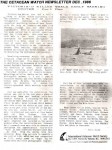 Early research: The Cetacean Watch Newsletter , Dec 1986. A Discussion of Victoria’s Killer whale early warning system, and the installation of the first hydrophone at Race Rocks.(1986)
Early research: The Cetacean Watch Newsletter , Dec 1986. A Discussion of Victoria’s Killer whale early warning system, and the installation of the first hydrophone at Race Rocks.(1986)
Link to the Ecotourism problems page:
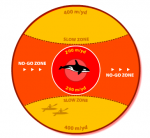 Link to the Be Whale Wise website for viewing guidelines
Link to the Be Whale Wise website for viewing guidelines
Other Members of the Class Mamalia at Race Rocks.
and Image File |
 The Race Rocks taxonomy is a collaborative venture originally started with the Biology and Environmental Systems students of Lester Pearson College UWC. It now also has contributions added by Faculty, Staff, Volunteers and Observers on the remote control webcams. The Race Rocks taxonomy is a collaborative venture originally started with the Biology and Environmental Systems students of Lester Pearson College UWC. It now also has contributions added by Faculty, Staff, Volunteers and Observers on the remote control webcams. |
Jaffar Saleh Subaie PC yr 27

